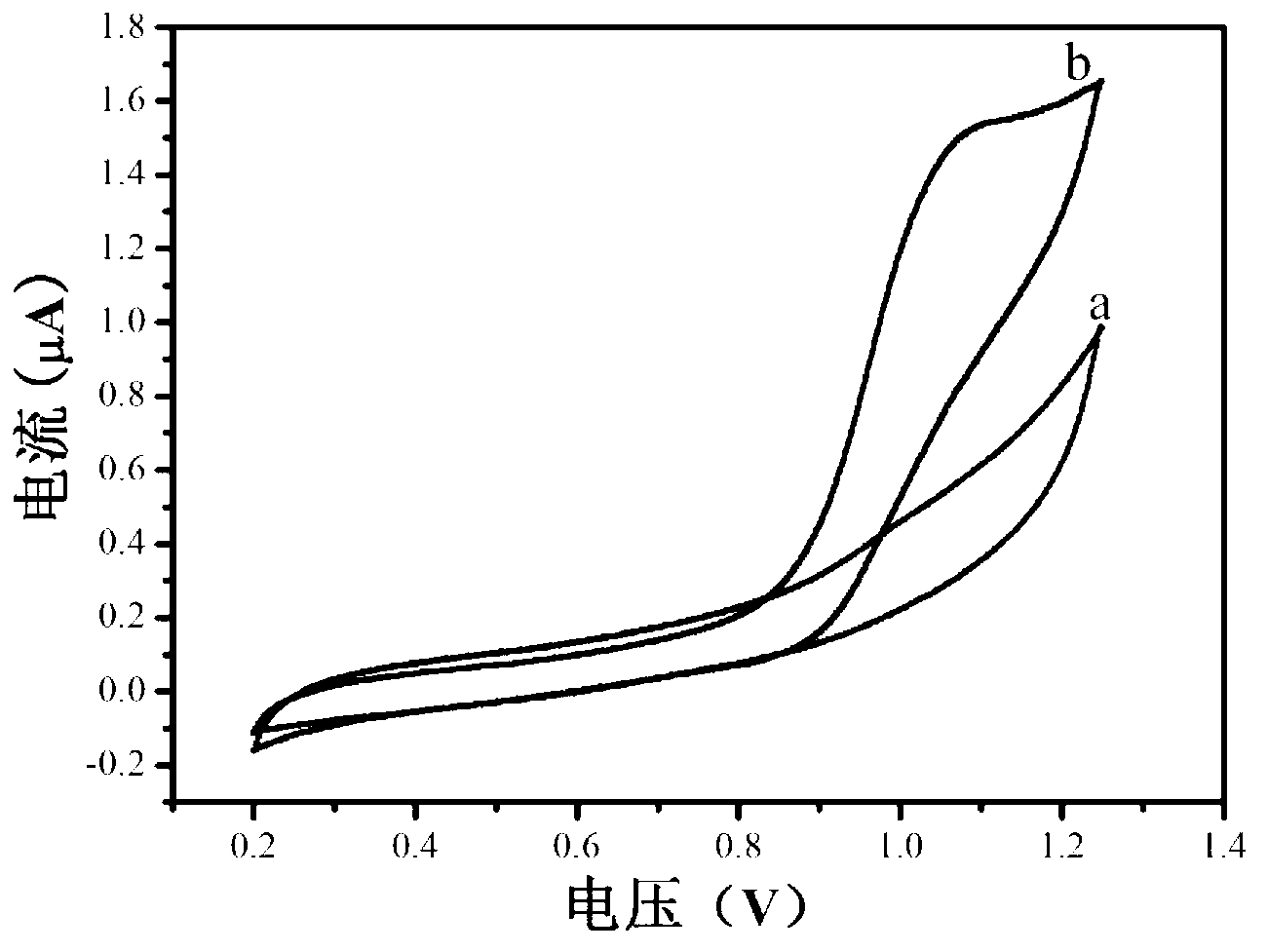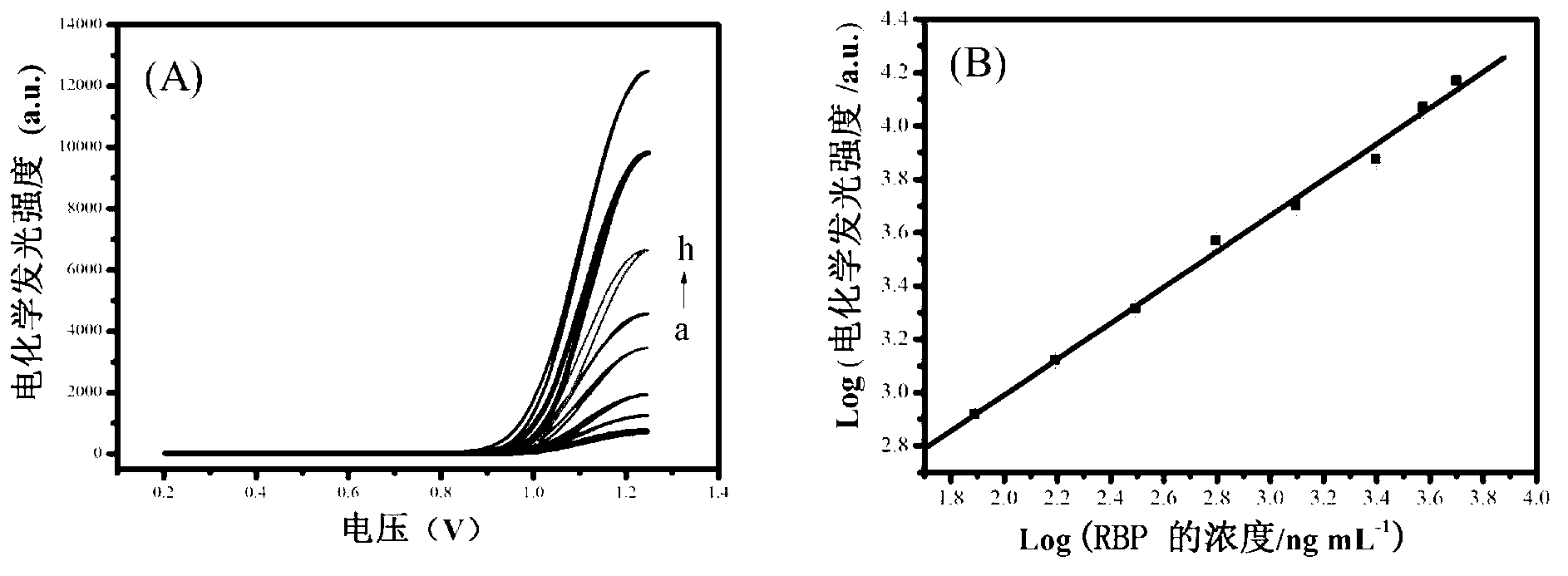Novel electrochemiluminescence immunosensor for rapid and high sensitive detection of retinol binding protein and its preparation method
A technology for sensitive detection and binding of proteins, applied in the field of biosensors, can solve the problems of insufficient immunosensor signal, narrow linear range, low binding rate, etc., and achieves a simple and easy construction method, wide linear range and good reproducibility. Effect
- Summary
- Abstract
- Description
- Claims
- Application Information
AI Technical Summary
Problems solved by technology
Method used
Image
Examples
Embodiment 1
[0024] Example 1: Preparation of Double Antibody Sandwich Type Immunosensor
[0025] 1) 10mg of synthesized SiO 2 Nanoparticles were dispersed in 5mL Nafion (5wt%)-ethanol solution and stirred in an ice bath for 4 hours to obtain Nafion-coated SiO 2 (NafionSiO 2 ) solution, the solution is centrifuged (rotating speed is 10000rpm, temperature is 4°C);
[0026] 2) Disperse the obtained solid particles in 2mL PBS (0.01M) (pH7.4), inject 600mL mouse anti-RBP (39μg / mL), stir continuously in an ice bath for 6 hours, centrifuge and dissolve in 1mL pH=7.4 PBS (0.01M);
[0027] 3) Add 1mL of 30mM Ru(bpy) 3 Cl 2 Add to 1 mL of the above NafionSiO with secondary antibody 2 Suspension of Ru(bpy) in the ice bath was continuously stirred for 1 hour, and the Ru(bpy) 3 Cl 2 Adsorbed to NafionSiO linked to secondary antibody 2 The surface of the complex was centrifuged to obtain RBP secondary antibody-labeled Ru–NafionSiO 2 Composite nanoparticles;
[0028] 4) The obtained composite...
Embodiment 2
[0035] Example 2: Ru–NafionSiO labeled with RBP monoclonal antibody 2 Electrochemical Behavior of Glassy Carbon Electrodes Modified by Composite Nanoparticles and Multi-walled Carbon Nanotubes
[0036] 10 μL RBP secondary antibody and 10 μL RBP secondary antibody-labeled Ru–NafionSiO were respectively modified on the glassy carbon electrode modified with multi-walled carbon nanotubes 2 The composite nanoparticle solution was tested for electrochemical behavior in 4mL PBS (pH8.0) detection cell containing 0.25mM TPA. There was basically no electrical signal between the single RBP antibody and the electrode modified by multi-walled carbon nanotubes, but the RBP secondary antibody labeled Ru–NafionSiO 2 The peak current of the electrode modified by composite nanoparticles and multi-walled carbon nanotubes is significantly increased, and there is a pair of Ru(bpy) 3 2+ The characteristic redox peak of ( figure 2 ), indicating that RBP secondary antibody-labeled Ru–NafionSiO ...
Embodiment 3
[0037] Example 3: Electrochemical Impedance Characterization of the Construction Process of Double Antibody Sandwich Type Immunosensor
[0038] During the modification process of the electrode, it was characterized by electrochemical impedance method. First place the treated bare glassy carbon electrode in 4mL K 3 Fe(CN) 6 / K 4 Fe(CN) 6 In impedance solution (5mM), the impedance value is very small, as the electrode surface is modified layer by layer with RBP primary antibody, BSAT, antigen, and RBP secondary antibody-labeled Ru–NafionSiO 2 The impedance value of the composite nanoparticles also increases, indicating that the modifiers are well fixed on the electrode surface.
PUM
 Login to View More
Login to View More Abstract
Description
Claims
Application Information
 Login to View More
Login to View More - R&D
- Intellectual Property
- Life Sciences
- Materials
- Tech Scout
- Unparalleled Data Quality
- Higher Quality Content
- 60% Fewer Hallucinations
Browse by: Latest US Patents, China's latest patents, Technical Efficacy Thesaurus, Application Domain, Technology Topic, Popular Technical Reports.
© 2025 PatSnap. All rights reserved.Legal|Privacy policy|Modern Slavery Act Transparency Statement|Sitemap|About US| Contact US: help@patsnap.com



